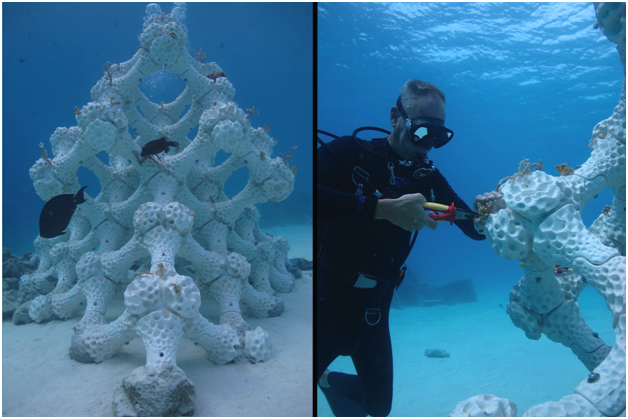Preliminary Research and Documentation
The following research and documentation is meant to get this project started. Please consider this a work in progress. Significant work is needed to move this project forward.
Requirements
- Structure and Material - Natural corals are made of calcium carbonate (limestone). We need to investigate if we can print using calcium carbonate and other materials that are are sturdy and eco-friendly. The structure must be sturdy enough to withstand underwater currents and impact by big fish. The coloring must look natural.
- Inside the structure - The structure needs to have chambers or crevices that fish can use to hide from predators. Or make it their home. Fish love that. When designing the structure, we need to ensure that there is enough natural lighting in the crevices. Also we need to investigate if we can add artificial lighting and maybe even a camera to study polyps and other marine life.
- Rooting the structure - Natural corals tend to grow roots and grow into the in the ocean bed. The 3D printed coral must have a rooting structure that can be drilled into the ocean floor. This will make the overall structure sturdy enough to withstand under water currents and impact by big fish.
Figure 3 - Coral reef installation
References
In 1997 the first Saya de Malha expedition was conducted by Wolf Hilbertz, Thomas Goreau, Kai Hilbertz and Caroline Mekie. Due to the distance and cost of getting there, only 1.5 days could be spent on site on the North Bank. Several dives were conducted, about 1.5 hours of underwater video was taken documenting the fauna and flora, and a small Biorock™ coral nursery was constructed, powered by a single floating solar panel. The area was found to be dominated by seagrasses, but small coral reefs were found with a very high diversity of coral and fish species.
Surprisingly these reefs were not dominated by any one group of corals, as is typical of most Indian Ocean reefs. Instead the coral populations consisted of small numbers of many different groups of corals, widely distributed. The larger corals were mostly rounded heads of Porites, or clumps of columnar Heliopora or Millepora, with smaller corals of many kinds around them. Many corals were observed to be loosely attached to the bottom, and many were being attacked by boring sponges, by several distinct coral diseases, or had algae overgrowing their edges.
Detailed information is available in the Saya de Malha Expedition (2002) report.
Also See
Dr. David Vaughan at the Mote Laboratory is growing coral 40 times faster than in the wild. The lab takes a coral that is about as big as a golf ball and cut it into 20 to 100 micro-fragments. Each fragment grows back in a few months. Detailed information and links are available in the Micro-Fragmenting report.
Related Projects
Marine Restoration - Coral Reefs
Licensing
This project is being developed as an open-source project with the following licensing:
- Software: GPL-3.0 - https://www.gnu.org/licenses/gpl-3.0.en.html
- Hardware, Design & other Intellectual Property: CC-BY-SA-4.0 - https://creativecommons.org/licenses/by-sa/4.0/

